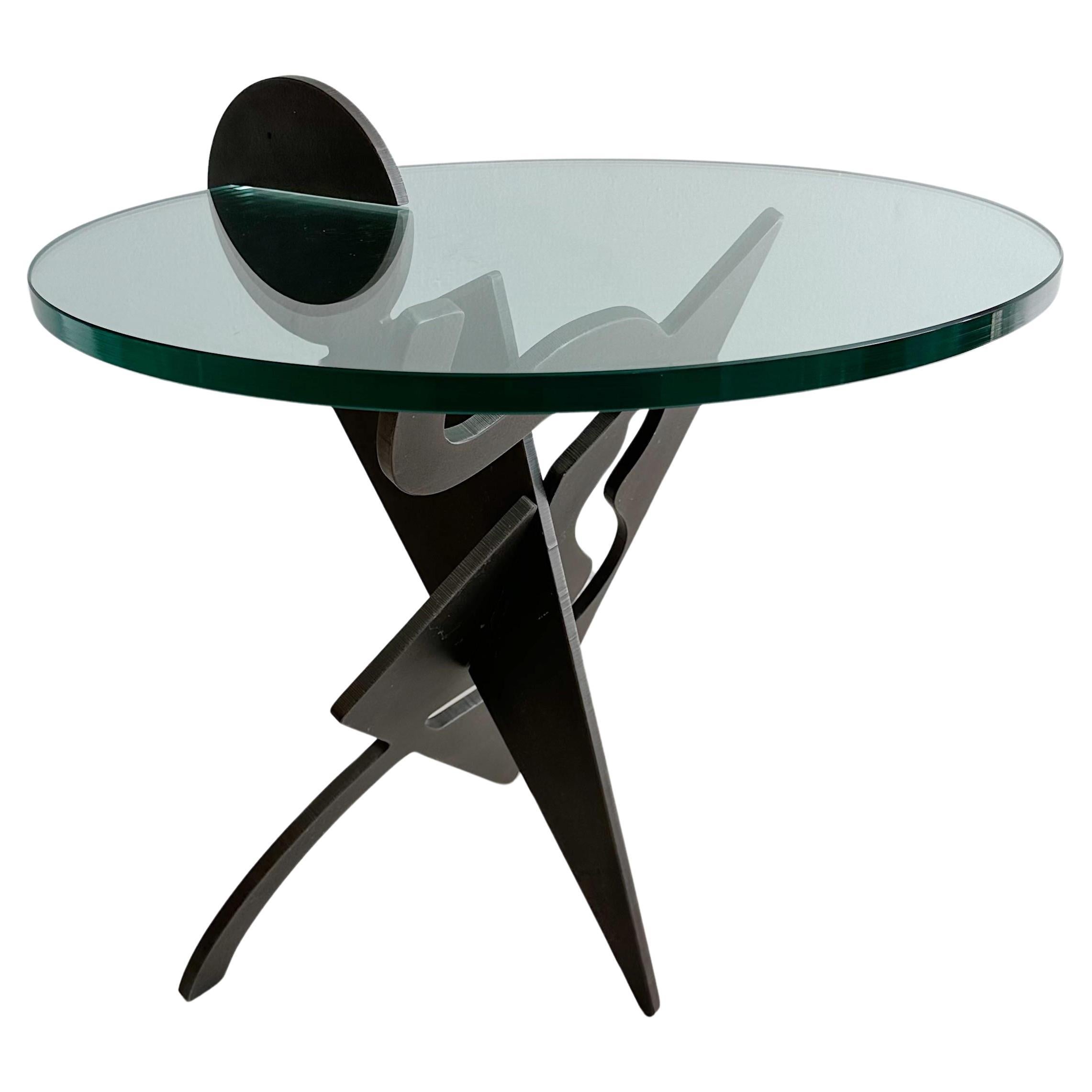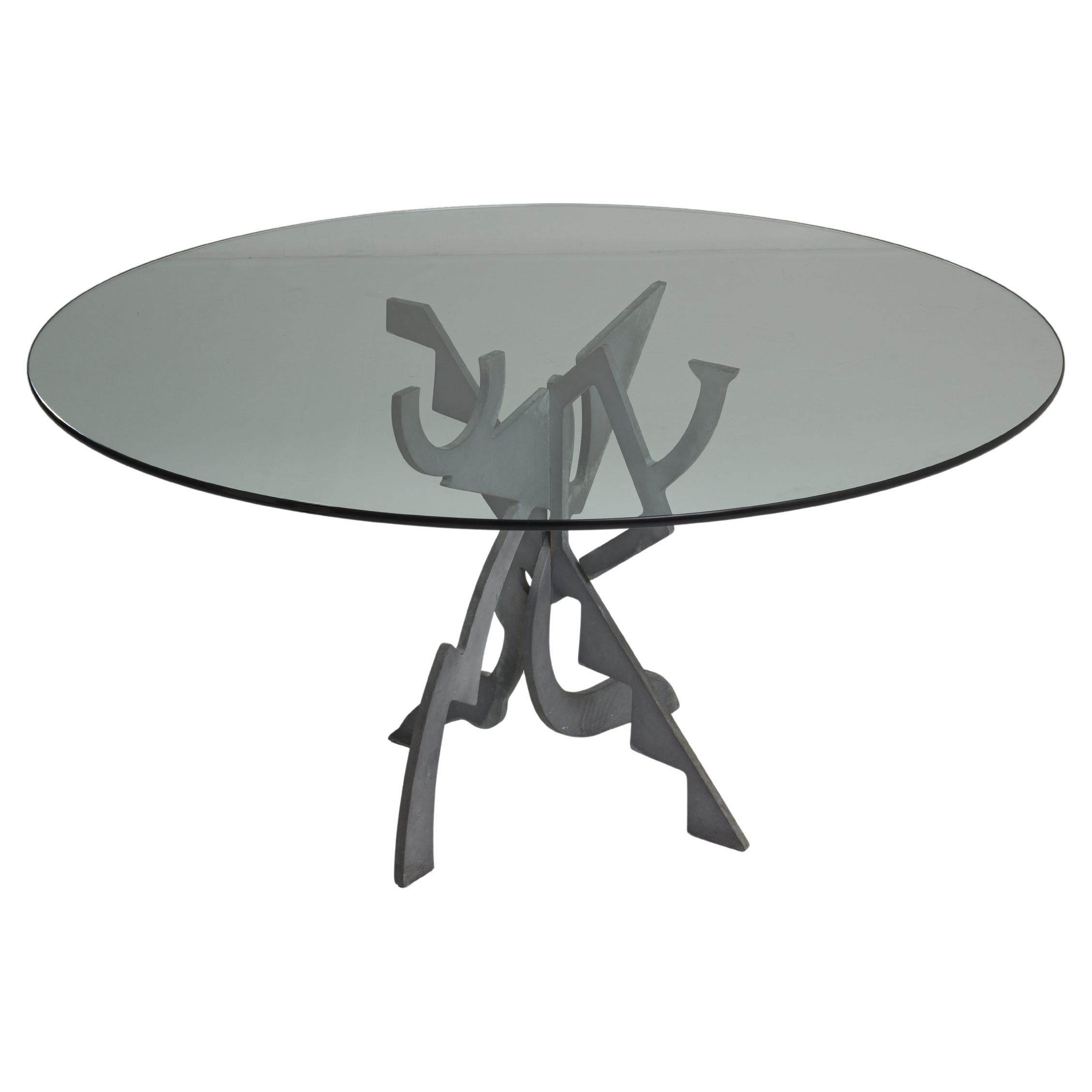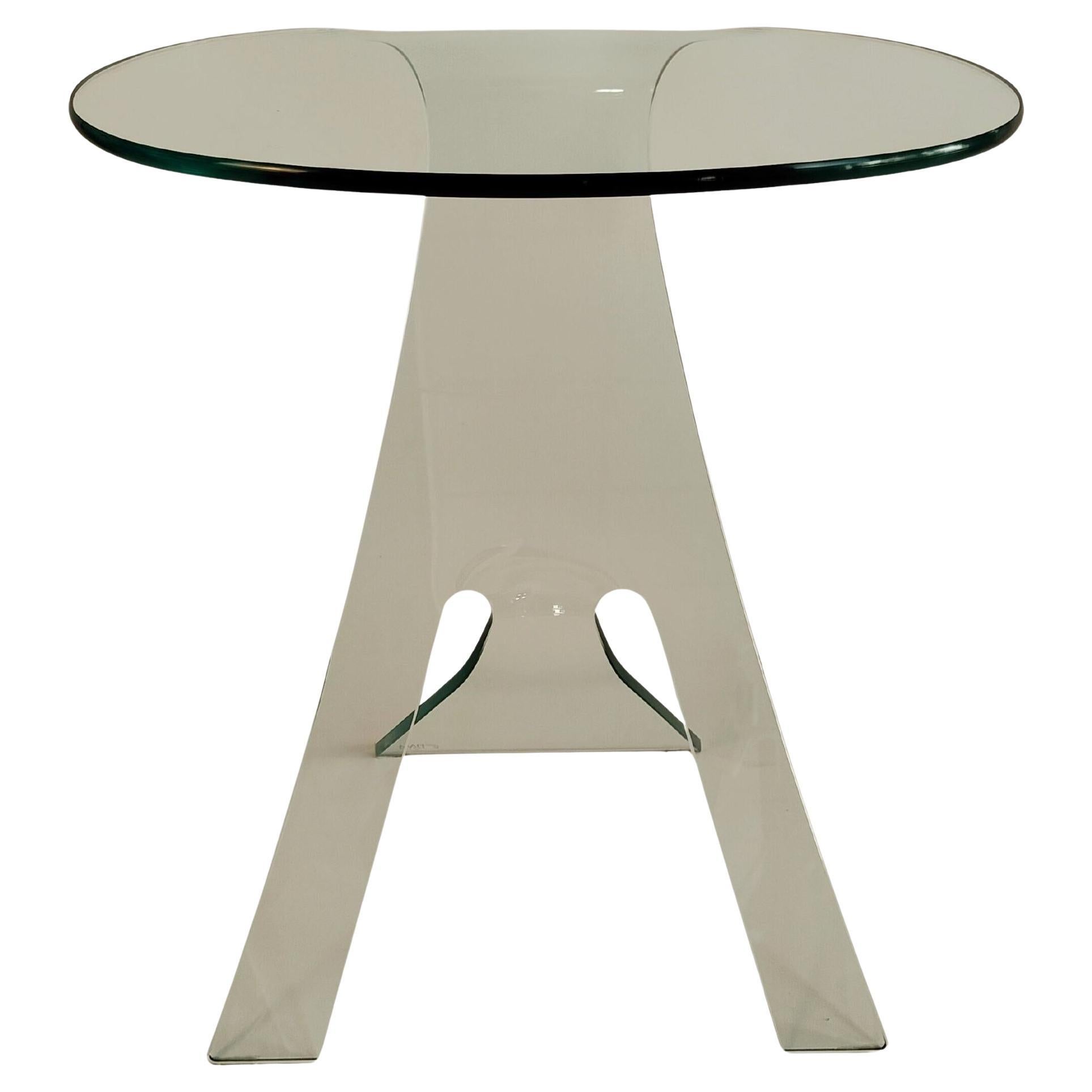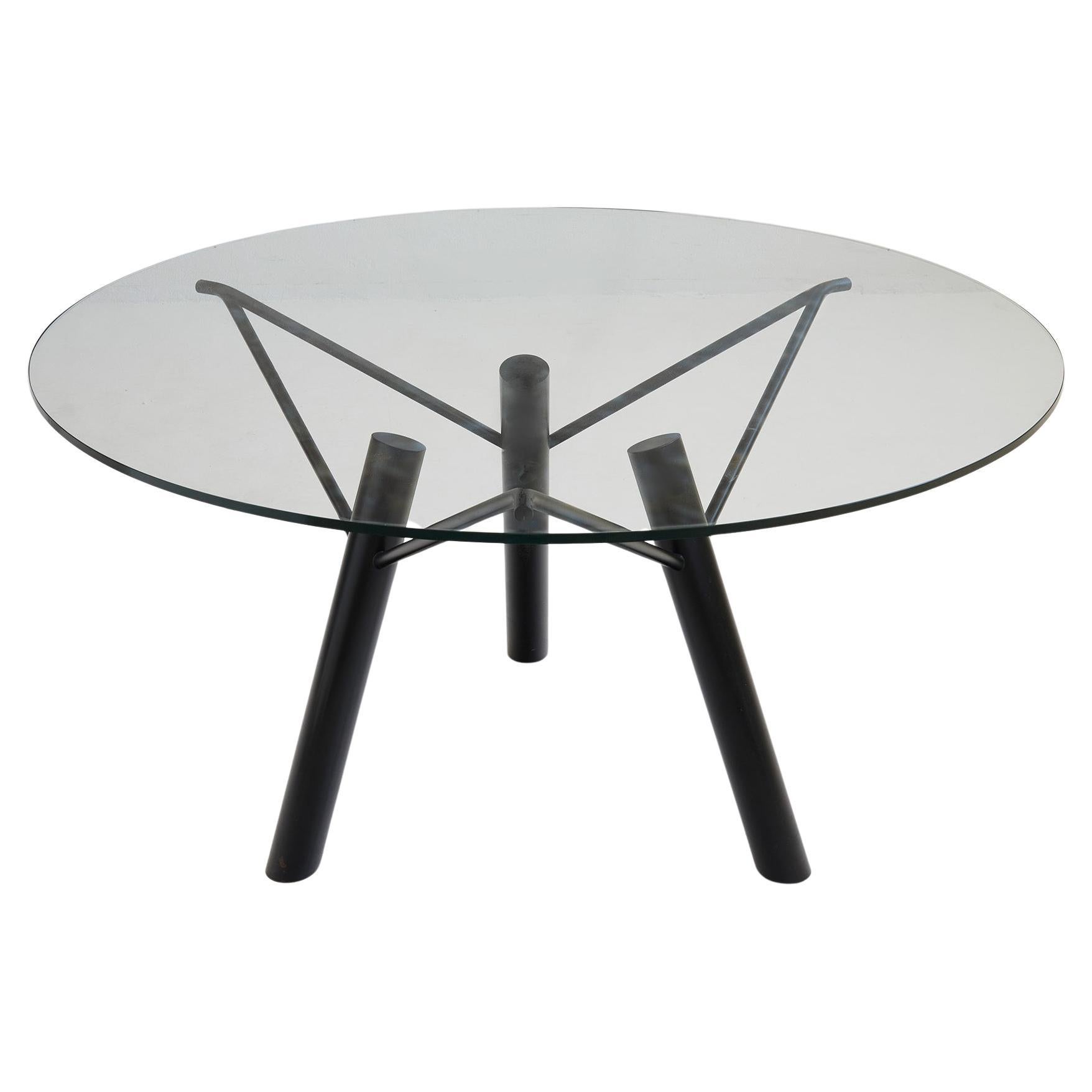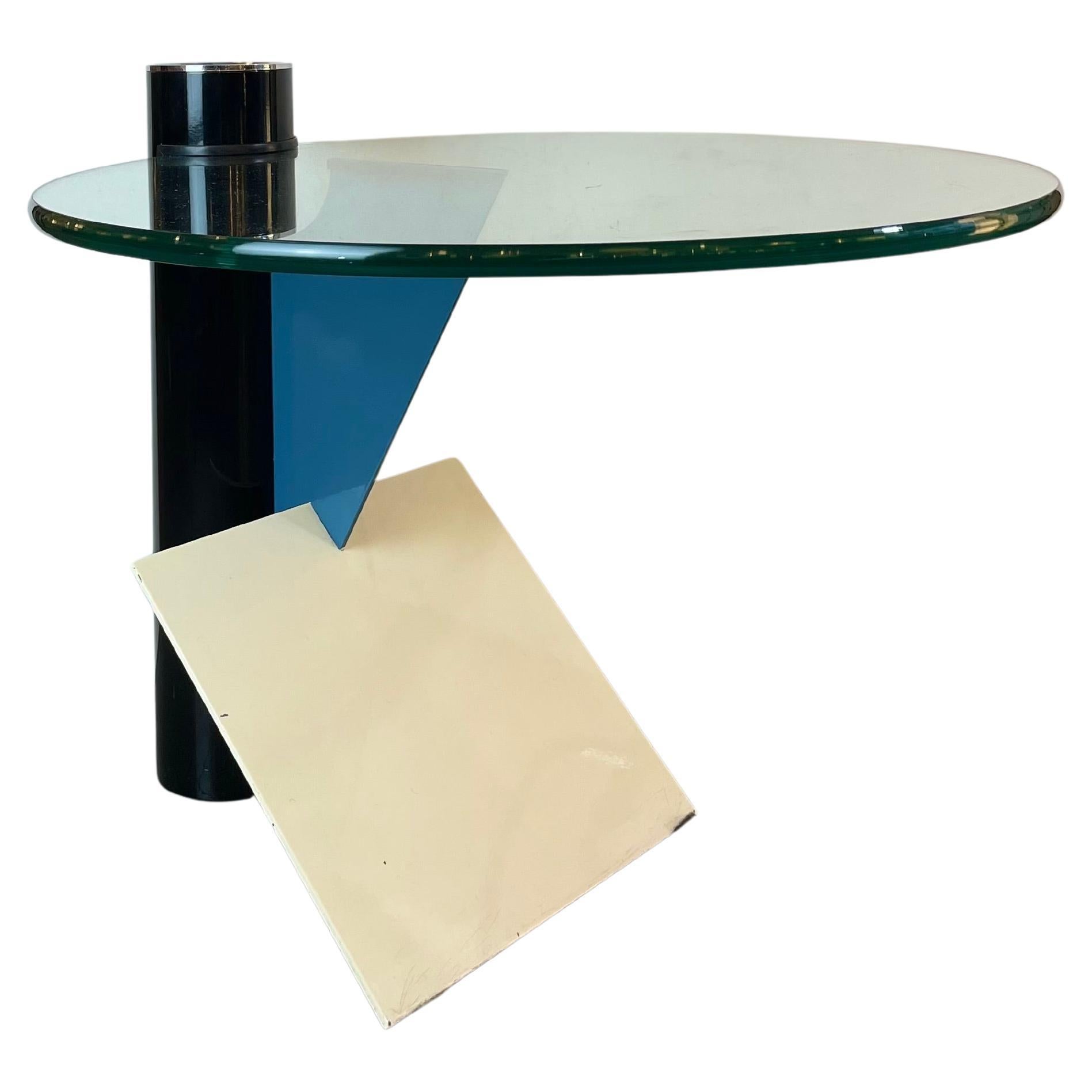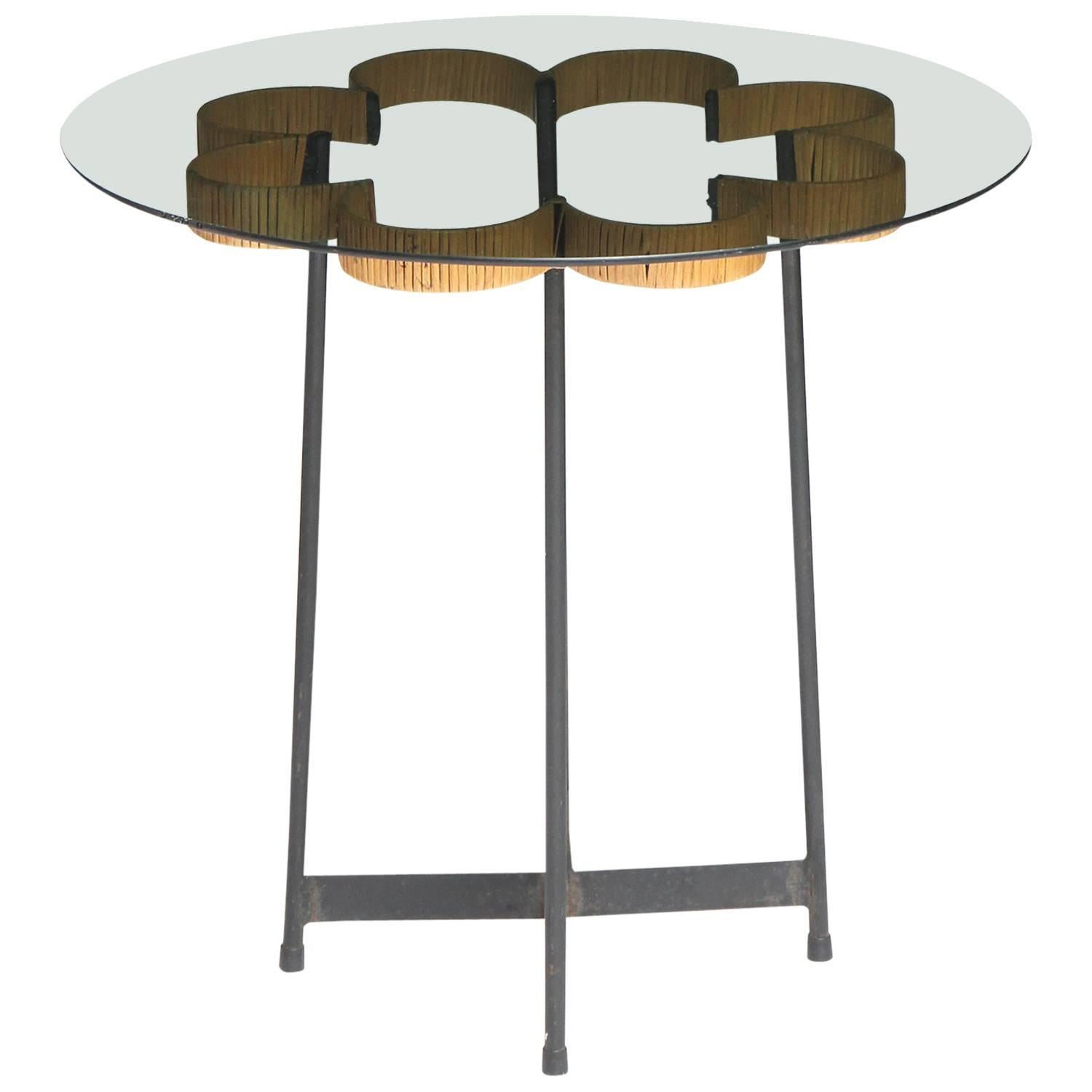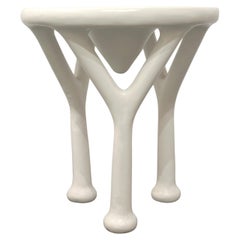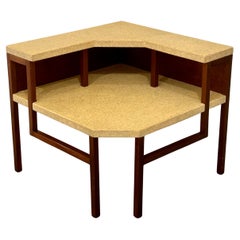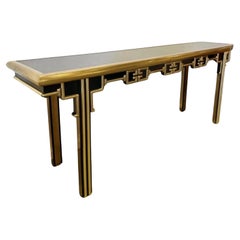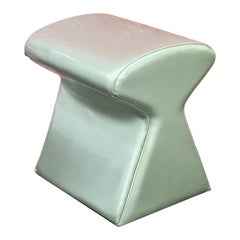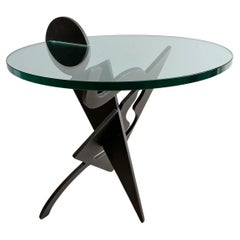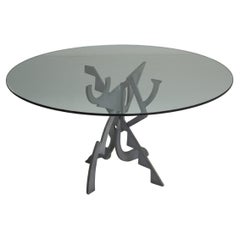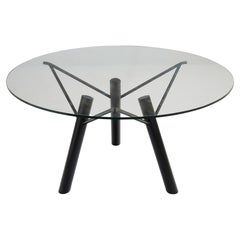Objekte ähnlich wie Pucci De Rossi for H Dolin Stuart Signed Battista Occasional Table, 1987
Video wird geladen …
Möchten Sie mehr Bilder oder Videos?
Zusätzliche Bilder oder Videos von dem*der Anbieter*in anfordern
1 von 16
Pucci De Rossi for H Dolin Stuart Signed Battista Occasional Table, 1987
2.419,16 €
Angaben zum Objekt
Pucci De Rossi for H Dolin Stuart Signed Battista Occasional Table, 1987
A delightful postmodern sculptural side table with an interlocking charcoal color metal base with glass top by Italian-born, Paris-based designer and artist Pucci de Rossi. Signed and dated 1987 at the base.
The. table measures 28" high x 23-1/2" wide x 22" deep overall. The glass top is 3/4' thick and measures 22" diameter. The glass top surface is 24-3/8" high.
There are some light scratches in the glass that are not distracting when viewed at a normal distance. There is a chip at the edge of the glass that presents as green but is hidden where the glass attaches under the frame so it is not seen. Otherwise, light scratches as expected in an item of this age, See photos for full condition. In rather remarkable condition for its vintage.
Among the army of designers from the 1980s and ’90s plucked from the archive in recent years — Ettore Sottsass, Nathalie du Pasquier, and their Memphis cohort, to name a few — there are still many that remain ripe for rediscovery. Our latest find is Pucci de Rossi, the Italian-born artist and designer who intrigued and confused the Parisian design world with his Brutti Mobili (Ugly Furniture). A clear predecessor to a whole cohort of artist-designers working today — think Misha Kahn’s mixed media chimeras — Pucci de Rossi didn’t invent the concept of functional art, but his work from the 1970s to 1990s certainly laid some groundwork.
Born in the Northern Italian city of Verona, Pucci was a tinkerer at heart. The trajectory of his practice simply followed what kind of materials were available to him at the time. In the early days, under the tutelage of American sculptor Brooks Walker, he worked with found objects, gathering old furnishings and discarded objects to create Frankenstein-like medleys inspired by the Surrealist paintings of Dalí and De Chirico at his home on the banks of the Adige river. “Pucci began his artistic life before the arrival of Postmodern design,” writes Nancy Huston in a monograph dedicated to his work, “at a time when no one raised the problems of the relationship between artists and artisans, and the word ‘design’ had not yet undergone the inflation that we know today.”
A contemporary of the Memphis movement, he held Ettore Sottsass and his ilk in high regard, but, recalls his widow, gallerist Mathilde Baralhé: “Pucci did not define himself as a designer but more as a visual artist, he designed his own objects and very rarely worked for serialization. He was therefore not constrained by any technical specifications and could let his imagination run wild. He was a creator of forms in space which kept a function to his creations. Pucci was a sculptor who played with furniture, shapes, materials and styles.”
In the 1970s, Pucci left Vicenza and moved to Paris with his first wife, the French writer and artist Laure Vernière. Arriving in the capital signaled a creative boom time for Pucci. From his flat in the Bastille district, he would scour the streets collecting detritus from the artisans and craftspeople that populated the neighborhood, which he would then transform into his infinitely kinetic assemblages: “Zinc torn off the roof by the roofers, abandoned furniture, debris of all sorts could be found on the sidewalks. All these materials, tools, bistro awnings, old signs, ordinary wood, wire, plastic… were a gold mine for me… I could find everything in the neighborhood. After, came the idea,” he once said.
In the monograph, Huston describes these amalgams as anthropomorphic furniture. “The seats can’t stand still,” she writes. “Structures are crossed by fluid forms; struck by a cramp, a Chippendale leg becomes taut, its lion’s claws have dropped their ball. The seats become animated, their backs, their legs and their arms start to move. An Art Nouveau curve balances a molding with a right angle, improbable compartments with their knobs act as the left arm. Under the undulating seat are four disparate legs: a baroque scroll, a baluster and two geometric volumes. Asymmetrical, dislocated, lop-sided, the monster leaning on its crutch seems to raise its shoulder to start a burlesque dance or to flee, like Dr. Frankenstein’s creature or the furniture of Maupassant’s short story.”
Despite his prolificacy, it wasn’t until the mid-80s that Pucci could be tacked on to a coherent design movement. As his profile grew, he became known as the continental answer to the group called ‘The London Scrapdealers’ — an ad hoc movement made up of André Dubreuil, Tom Dixon, Mark Brazier Jones and Nick Jones who similarly employed found objects and contorted junk metal in their work. It was a mode of working that was unstudied and untaught, a reaction to the 1980s chrome-plated minimalism. “People were fed up with the minimal, they wanted curves and what they liked was the salvaging aspect, messed up, Arts & Crafts, to use the English term. We didn’t do drawings, we executed spontaneously,” Dubreuil said of the early Postmodernists. Finally, the style Pucci had been nurturing for decades was having a moment.
It was around this time that Pucci began working with Paris gallery Néotu, where he would produce a succession of collections in his proto-Nickelodeon aesthetic. Distorted furniture inspired by Dali (Hommage à Dalí, 1989), deconstructivist-style three-dimensional collages in metal and wood (Introibo ad altare dei, 1987) lamps spliced with shards of glass (Le Gardien du trésor, 1985), undulating plywood monoliths (Trois Fois rien,1991) and steampunk-like assemblages of wooden artifacts gleaned from forgotten chairs (Remake, 1993) all became examples of Pucci’s dogged eclecticism.
Paris also introduced Pucci to the kind of patrons who would allow his creative impulses to run free. The most influential among them was auctioneer Jean-Claude Binoche, known for his contemporary art and design sales, who commissioned Pucci to design the dining room and office in his Paris home, and later on, his sprawling Palazzo in Venice, which would become the most fully realized expression of Pucci’s idiosyncratic melding of art and design. A built-in sleigh bed formed in the shape of baroque scrolls, hand-painted technicolor murals on the building’s ancient rafters and furniture plucked from Pucci’s various collections over the years made up the extravagantly bizarre Venetian home.
“A man apart, gifted with overflowing ingenuity and inventiveness. It was not always easy to follow his thoughts every day, he was always thinking about the meaning of things, of life, of himself,” recalls Mathilde, who lived with Pucci at his Bastille apartment until he passed away in 2013.
Of his legacy, she writes: “The object that reflects this feeling is the J.A.R. mirror (Jamais Assez De Reflection/Never Enough Reflection), on one side a mirror, on the other a self-portrait. But unlike many other artists, Pucci was not self-centered, he was very available with his friends and relatives. He was very sensitive to people. He could be light and deep at the same time. He followed the impulses of his heart. But he was also a bon vivant who liked to party. What I liked about him was his humor, his mischievousness and the offbeat vision he had of the world: ‘I have to constantly change the reality that surrounds me, my work is an example of this and it is perhaps the way of expressing myself that suits me best’ [he once said]. Living with Pucci was like living a daydream. He was an everyday poet.”
Source: Sight Unseen
- Schöpfer*in:Pucci De Rossi (Designer*in)
- Maße:Höhe: 71,12 cm (28 in)Breite: 59,69 cm (23,5 in)Tiefe: 55,88 cm (22 in)
- Stil:Postmoderne (Aus dem Zeitalter)
- Materialien und Methoden:
- Herkunftsort:
- Zeitalter:1980–1989
- Herstellungsjahr:1987
- Zustand:Abnutzung dem Alter und der Nutzung entsprechend. There are some light scratches in the glass that are not distracting when viewed at a normal distance. There is a chip at the edge of the glass that presents as green and but is hidden where the glass attaches under the frame.
- Anbieterstandort:Cathedral City, CA
- Referenznummer:Anbieter*in: OC98651stDibs: LU8352245433332
Anbieterinformationen
5,0
Gold-Anbieter*in
Premium-Anbieter*innen mit einer Bewertung über 4,3 und 24 Stunden Reaktionszeit
Gründungsjahr 2000
1stDibs-Anbieter*in seit 2023
23 Verkäufe auf 1stDibs
Typische Antwortzeit: <1 Stunde
- VersandAngebot wird abgerufen …Versand von: Cathedral City, CA
- Rückgabebedingungen
Einige Inhalte dieser Seite wurden automatisch übersetzt. Daher kann 1stDibs nicht die Richtigkeit der Übersetzungen garantieren. Englisch ist die Standardsprache dieser Website.
Authentizitätsgarantie
Im unwahrscheinlichen Fall eines Problems mit der Echtheit eines Objekts kontaktieren Sie uns bitte innerhalb von 1 Jahr für eine volle Rückerstattung. DetailsGeld-Zurück-Garantie
Wenn Ihr Objekt nicht der Beschreibung entspricht, beim Transport beschädigt wurde oder nicht ankommt, kontaktieren Sie uns bitte innerhalb von 7 Tagen für eine vollständige Rückerstattung. DetailsStornierung innerhalb von 24 Stunden
Sie können Ihren Kauf jederzeit innerhalb von 24 Stunden stornieren, ohne jegliche Gründe dafür angeben zu müssen.Geprüfte Anbieter*innen
Unsere Anbieter*innen unterliegen strengen Dienstleistungs- und Qualitätsstandards, wodurch wir die Seriosität unserer Angebote gewährleisten können.Preisgarantie
Wenn Sie feststellen, dass ein*e Anbieter*in dasselbe Objekt anderswo zu einem niedrigeren Preis anbietet, werden wir den Preis entsprechend anpassen.Zuverlässige weltweite Lieferung
Unsere erstklassigen Versandunternehmen bieten spezielle Versandoptionen weltweit, einschließlich individueller Lieferung.Mehr von diesem*dieser Anbieter*in
Alle anzeigenJohn Dickinson Lackierter Y-Tisch, ca. 1970er Jahre
Von John Dickinson
John Dickinson Lackierter Y-Tisch, ca. 1970er Jahre
Dies ist ein seltener Y-Tisch (Modell 118) aus lackiertem Harz, entworfen von John Dickinson. Dies ist ein besonderer Tisch, der ...
Kategorie
Vintage, 1970er, amerikanisch, Organische Moderne, Beistelltische
Materialien
Harz, Lack
Ecktisch aus Kork und Mahagoni, Paul Frankl für Johnson Furniture, ca. 1951
Von Johnson Furniture Company, Paul Frankl
Ecktisch aus Kork und Mahagoni, Paul Frankl für Johnson Furniture, ca. 1951
Einzigartiger großer Ecktisch, der perfekt zu zwei größeren Sofas aus der Mitte des Jahrhunderts passt, d...
Kategorie
Mitte des 20. Jahrhunderts, amerikanisch, Moderne der Mitte des Jahrhund...
Materialien
Mahagoni, Kork
Mastercraft USA Elegante Konsole aus schwarzem Lack und Messing, ca. 1970er Jahre
Von Maitland Smith
Mastercraft USA Elegante Konsole aus schwarzem Lack und Messing, ca. 1970er Jahre
Wunderschöner und langer Mastercraft Konsolentisch aus schwarzem Lack und Messing mit griechischem ...
Kategorie
Vintage, 1970er, amerikanisch, Hollywood Regency, Konsolentische
Materialien
Messing
Karim Rashid Silber-Vinyl-SchRaumhocker für IDEE Limitierte Auflage, signiert und nummeriert
Von Karim Rashid, Idée Japan
Karim Rashid Shroom Stool, entworfen für IDEE, Japan, 1998. Diese silberne Vinylversion war eine limitierte Auflage und ist auf dem mit IDEE beschrifteten Stoff an der Unterseite des...
Kategorie
1990er, Japanisch, Futuristisch, Hocker
Materialien
Polster, Synthetik, Schaumstoff, PVC
Organischer moderner geschnitzter Kiefernholzhocker oder skulpturales Objekt von Daniel Pollock, 1995
Von Daniel Pollock
Daniel Pollock organischer moderner geschnitzter Holzhocker oder skulpturales Objekt, handgeschnitzt aus Kiefernholz. Es handelt sich um ein sehr schweres Stück, und die Unvollkommen...
Kategorie
1990er, amerikanisch, Organische Moderne, Hocker
Materialien
Holz, Kiefernholz
Yasha Heifetz Rotaflex-Tischlampe in Übergröße, ca. 1950er Jahre
Von Heifetz Rotaflex, Heifetz, Yasha Heifetz
Yasha Heifetz Rotaflex Tischlampe, ca 1950er Jahre
Eine seltene Version der Heifetz Rotaflex-Lampe mit einem Schirm aus gesponnener Plastikschnur, der in einem durchbrochenen Messin...
Kategorie
Mitte des 20. Jahrhunderts, amerikanisch, Moderne der Mitte des Jahrhund...
Materialien
Metall, Messing
Das könnte Ihnen auch gefallen
Pucci De Rossi (1947-2013) Beistelltisch „Battista“
Von Pucci De Rossi
Pucci De Rossi, Pucci
(1947-2013)
Beistelltisch mit zwei ineinandergreifenden Platten aus ⅝" dickem Stahl, die in abstrakte Formen geschnitten sind, mit einem Stück 3/4" x24" neuem G...
Kategorie
Vintage, 1980er, amerikanisch, Moderne der Mitte des Jahrhunderts, Beist...
Materialien
Stahlschnitt
Tischskulptur Pucci De Rossi 'Tristan und Isolde' H. Dolin Stuart Frankreich 1987
Von Pucci De Rossi
PUCCI DE ROSSI (1947-2013) & H. DOLIN STUART
Tisch 'Tristan und Isolde', entworfen 1978, hergestellt 1987, Gestell aus grau lackiertem Stahl und Glasplatte.
Neotu-Ausgabe
H 73,5 × Ø ...
Kategorie
Vintage, 1980s, French, Moderne, Tische
Materialien
Eisen
FIAM Italia Vittorio Livis Couchtisch "Grillo", geschwungenes Kristall, Italien, 1980
Von Vittorio Livi, FIAM
Grillo Couchtisch aus gebogenem Glas, entworfen von Vittorio Livi für FIAM Italia, um 1980. Eine einzelne Scheibe aus gebogenem Glas mit den Maßen 62x53x39 cm und einer Dicke von 12 ...
Kategorie
Vintage, 1980s, Italian, Postmoderne, Beistelltische
Materialien
Kristall
Esstisch "Orrido Canyon" von Mireille Rivier und Paolo Pallucco, Italien 1987
Von Paolo Pallucco & Mireille Rivier, Pallucco
Esstisch "Orrido Canyon" von Mireille Rivier und Paolo Pallucco, Italien 1987
Er verfügt über einen skulptural geformten Sockel mit drei zylindrischen, abgewinkelten Beinen. Eine ru...
Kategorie
Vintage, 1980er, Italienisch, Postmoderne, Esstische
Materialien
Metall
Postmoderner Beistelltisch „ Memphis“ von Peter Shire für Saporiti, 1980er Jahreu2028
Von Peter Shire, Saporiti
Seltener Memphis Postmodern Beistelltisch aus schwarz, blau und beige emailliertem Stahlgestell mit einer Glasplatte und einem verchromten Aufputz. Entworfen von Peter Shire für die ...
Kategorie
Vintage, 1980er, Italienisch, Postmoderne, Beistelltische
Materialien
Stahl, Chrom
Beistelltisch von Arthur Umanoff
Von Tony Paul
Ein ausdrucksstarker und ungewöhnlicher Beistelltisch mit Glasplatte, der die Form von acht miteinander verbundenen, mit Rattan umwickelten Loops hat, die auf einem sparsamen archite...
Kategorie
Vintage, 1950er, amerikanisch, Moderne der Mitte des Jahrhunderts, Beist...
Materialien
Glas, Rattan
